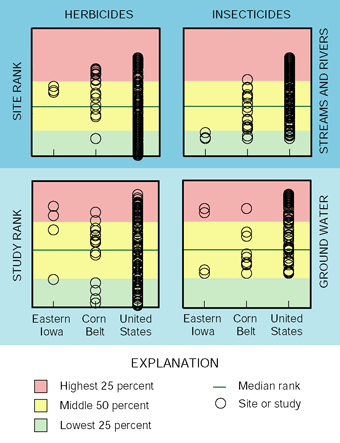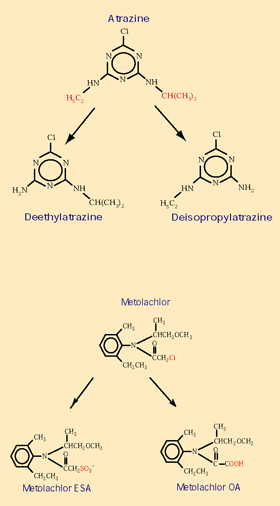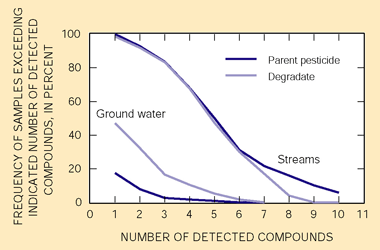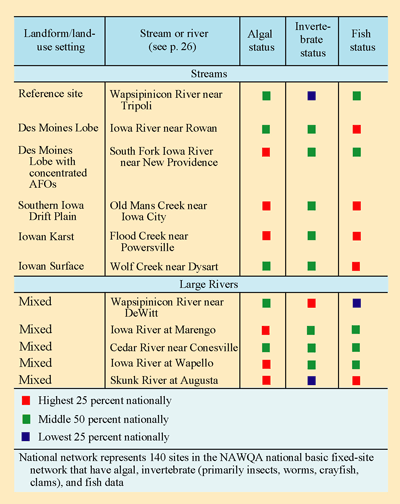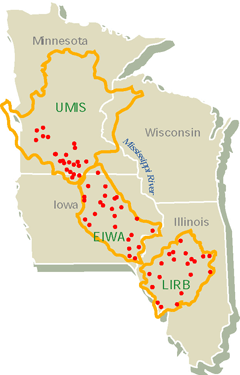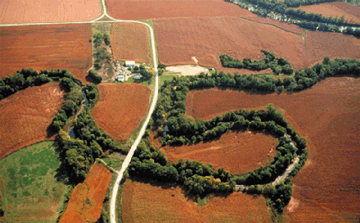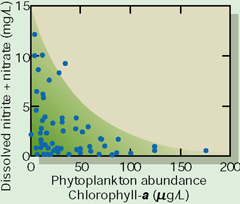MAJOR FINDINGS—Continued
Pesticides in Ground Water and Streams
Pesticides (herbicides and insecticides) are used extensively in agricultural and urban settings in the Eastern Iowa Basins to control unwanted vegetation and insects. Triazine (atrazine and cyanazine) and chloroacetanilide (alachlor and metolachlor) herbicides were the most extensively used pesticides during 1996–98. However, in 1994, acetochlor, a herbicide conditionally registered by the USEPA, began to replace alachlor. In 1998, acetochlor use exceeded all other herbicides in Iowa (U.S. Department of Agriculture, 1999). Other classes of low-use herbicides (for example, sufonylurea and imidozolinone herbicides) also had become more popular. Genetically altered corn and soybeans that are resistant to glyphosate and genetically altered “Bt corn" that contains the genes allowing corn to produce compounds toxic to damaging insects also were beginning to change pesticide-use patterns. Although urban pesticide-use data were not available, herbicides commonly are used on lawns, golf courses, and road rights-of-way for weed control, and a wide range of insecticides are used for insect control.
Transport of pesticides from the site of application is dependent on the persistence of the compound, its solubility in water, and its tendency to adsorb to soil particles. Pesticide compounds break down at various rates due to biological and chemical processes. Pesticides can be broken down in the soil by bacteria and fungi and nonaffected plants and in streams by microorganisms, algae, and aquatic plants. The older organochlorine pesticides, most of which have been banned (for example, DDT) strongly attach to soil particles and are transported to streams primarily with sediment. In contrast, many herbicides commonly used in the 1990’s (for example, atrazine) are relatively soluble and are transported almost exclusively dissolved in water. Water is the primary mechanism by which most pesticides and their breakdown products (degradates) are leached to ground water. Water transports pesticides and their degradates to streams by overland flow, tile drains, and ground-water inflow.
Herbicide and insecticide concentrations in streams do not rank among the highest 25th percentile nationally (fig. 17) even though use in the Eastern Iowa Basins is high. Herbicide concentrations rank in the middle 50 percent nationally and in the middle one-third in the Corn Belt. Insecticide concentrations are among the lowest in the Corn Belt and Nation. Reasons for lower pesticide concentrations in the Eastern Iowa Basins compared to other parts of the Nation are not entirely clear but may include these: (1) although pesticide use is high in Eastern Iowa Basins it may be higher in other corn, cotton, and other crop-growing areas of the Nation and (2) soils in Eastern Iowa Basins may be relatively conducive to leaching to ground water or conditions are favorable for breakdown of the pesticides. In contrast, herbicide and insecticide concentrations in the alluvial aquifers in Eastern Iowa Basins are among the highest 25th percentile in the Corn Belt and Nation (fig. 17). Water in these aquifers has infiltrated within the last 20 years when the use of the analyzed pesticides was the greatest. Because water from the Silurian-Devonian and Upper Carbonate aquifers is generally deeper and has infiltrated before pesticides were commonly used, pesticide concentrations from these aquifers generally were among the lowest in the Nation. |
Pesticides in Ground Water
Herbicides are prevalent in the shallow alluvial aquifers. Herbicides are prevalent in the shallow alluvial aquifers but are not common in the deeper Silurian-Devonian and Upper Carbonate bedrock aquifers in the Eastern Iowa Basins. Atrazine and metolachlor were the most frequently detected herbicides in the alluvial aquifers and the Silurian-Devonian and Upper Carbonate aquifers. Atrazine was detected in more than 50 percent of the alluvial aquifer samples and in 18 percent of the Silurian-Devonian and Upper Carbonate aquifer samples. Metolachlor was detected in 20 percent of the alluvial samples and in 12 percent of the Silurian-Devonian and Upper Carbonate samples. Acetochlor was detected in slightly less than 2 percent of the alluvial aquifer samples but at concentrations less than 0.2 µg/L, which is the concentration of concern for conditional registration. Acetochlor was not detected in samples from the Silurian-Devonian and Upper Carbonate aquifers.
Pesticide degradates commonly constitute the majority of the pesticide mass analyzed. Many of the detected pesticides and pesticide degradates have no established drinking-water standard or aquatic-life criteria, and the potential for these compounds to affect humans or aquatic organisms is unknown. Alachlor ethanesulfonic acid (ESA), atrazine, and metolachlor ESA were detected in more than 30 percent of samples from shallow alluvial (fig. 18) and deep bedrock aquifers.
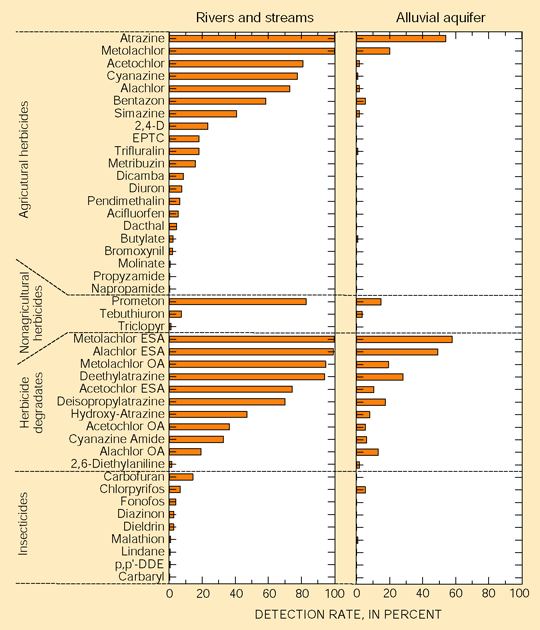 |
| Figure 18. The pesticide compounds present in streams and rivers and the alluvial aquifers, which are hydraulically connected, were similar but were detected less frequently in ground water. Agricultural herbicides and their degradates were most frequently detected. |
Agricultural and urban applications have resulted in sporadic low levels of insecticide contamination in the alluvial aquifers. Chlorpyrifos, an insecticide that was recently reevaluated by the USEPA for safety as part of the Food Quality Protection Act (U.S. Environmental Protection Agency, 2000b), was detected in about 7 percent of the urban land-use samples and about 13 percent of the agricultural land-use samples. The maximum concentration in urban areas (0.005 µg/L) was about four times lower than the maximum concentration in agricultural areas (0.021 µg/L). Malathion, an insecticide also currently (2000) under USEPA review, was detected in one sample from an urban land-use well.
Pesticides do not occur everywhere in the Study Unit, and when they do occur, concentrations can be highly variable. This variability in occurrence and concentration of various pesticide compounds in ground water is probably associated with several factors including the presence of overlying protective layers and land-use practices.
Clay and shale materials hinder movement of pesticides to aquifers. Clay and shale materials hinder movement of pesticides by slowing the movement of water containing pesticides to underlying aquifers. In some instances, water that has infiltrated the ground during the last 40 years when many of the studied compounds were used has not yet reached the deeper parts of the alluvial and bedrock aquifers. The age of the ground water was significantly younger and pesticide concentrations were significantly higher in samples from areas where an overlying bedrock confining unit was absent or where less than 100 feet of unconsolidated deposits overlies the Silurian-Devonian and Upper Carbonate aquifers. Water is most affected by surficial contamination near the top of alluvial aquifers where an overlying clay layer is thin or absent. Triazine pesticides and degradate concentrations were significantly higher in samples from wells in areas with a thin clay layer above the screened interval than those from wells in areas with thick overlying clay layers. Concentrations decreased with increasing depth in the alluvial aquifers. As with nitrate, these two results indicate that longer and slower flow paths (deeper sample and thicker clay layer) increase opportunities for sorption, degradation, and dispersion of pesticides and may contribute to decreases in pesticide concentrations with depth.
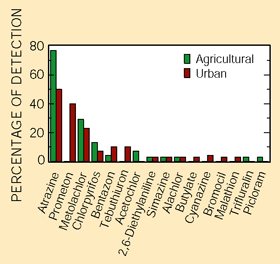 |
| Figure 20. Pesticides were frequently detected in the alluvial aquifers in both agricultural and urban areas. Although the total concentrations of pesticides were higher in agricultural areas than in urban areas, more compounds were detected in urban than in agricultural areas. |
Pesticides are present in alluvial aquifers both in urban and agricultural areas. Pesticides were prevalent in the shallow alluvial aquifers both in agricultural and urban areas (fig. 20). Pesticides were detected in 84 percent of the samples from agricultural areas and in 70 percent of the samples from urban areas. Atrazine and metolachlor were the most frequently detected pesticides in samples from agricultural areas; atrazine and prometon were the most frequently detected pesticides in samples from urban areas. None of the concentrations exceeded USEPA MCLs, but many pesticides do not have MCLs.
Samples from alluvial aquifers in agricultural areas contained an average total pesticide concentration (1.3 µg/L) that was more than seven times the concentration in samples from urban wells (0.17 µg/L). Although total pesticide concentrations were higher in samples from agricultural areas, more compounds were detected in samples from urban areas. Seventeen compounds were detected in samples from urban areas compared to 12 compounds detected in samples from agricultural areas. Herbicide degradates were detected in 94 percent of samples from agricultural areas and 53 percent of the samples from urban areas. Alachlor ESA, metolachlor ESA, and metolachlor oxanilic acid (OA) were the most frequently detected degradates in samples from both agricultural and urban areas; deethyl-atrazine and deisoproplyatrazine were detected frequently in agricultural areas.
Pesticides in Streams
The most commonly used herbicides were the most frequently detected. Atrazine and metolachlor, the two most commonly used herbicides in Iowa for row-crop agriculture during 1996–98, were detected in all stream samples (fig. 18). Acetochlor, alachlor, and cyanazine were detected in more than 70 percent of the samples. Most atrazine concentrations (76 percent) exceeded 0.1 µg/L with almost 60 percent of the samples in the 0.1 to 1.0 µg/L range (fig. 21). About 10 percent of the samples exceeded the atrazine MCL level of 3.0 µg/L. Almost half of the samples had metolachlor concentrations in the range from 0.1 to 1.0 µg/L (fig. 21). Other less frequently detected pesticides were carbofuran, 2,4-D, dicamba, EPTC, metribuzin, and trifluralin; these were applied in Iowa at a rate of only 0.6 to 30 percent of the amount applied for atrazine (Sands and Holden, 1996).
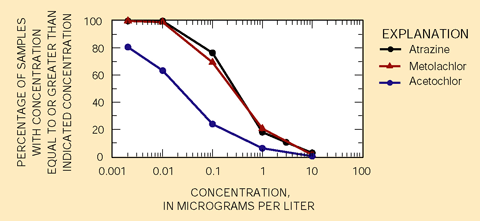 |
| Figure 21. Atrazine and metolachlor were present in more than 50 percent of the samples from rivers and streams at concentrations between 0.1 and 1.0 mg/L. In contrast, acetochlor was present in 76 percent of the samples at concentrations less than 0.1 mg/L. |
Acetochlor, a conditionally registered herbicide that is intended to replace a number of other commonly used herbicides, was frequently detected but most times (75 percent) at concentrations less than 0.1 µg/L. Acetochlor concentrations did not exceed the 2.0-µg/L annual mean concentration registration requirement at any site but did exceed this level in about 3 percent of the individual samples. The maximum concentration (10.6 µg/L) measured during the study exceeded the level that would trigger requirements for biweekly sampling for water-supply systems (U.S. Environmental Protection Agency, 1994).
Few nonagricultural herbicide compounds were detected. Many pesticides are used both in agricultural and urban settings, but only three herbicides used almost exclusively in non-row-crop agriculture and urban settings (prometon, tebuthiuron, and triclopyr) were present in streams in eastern Iowa and southern Minnesota from 1996 through 1998 (fig. 18). Prometon, a herbicide used for weed control around buildings, fence rows, and under asphalt, was present at very low concentrations (less than 0.1 µg/L) in more than 80 percent of the samples. Prometon is extremely persistent (half-life of hundreds to thousands of days), which may explain the relatively high detection rate relative to its low use. Tebuthiuron, used on road rights-of-way and industrial sites, was detected in 7 percent of the samples. Triclopyr, used on road rights-of-way, industrial sites, and turf grass, was detected in 1 percent of the samples.
 |
| Figure 22. Insecticides were prevalent in streams only during the late spring and summer. Carbofuran and chlorpyrifos were the most frequently detected insecticides. |
Insecticides were detected mainly during the summer. A number of insecticides that have been identified as posing a high risk to aquatic invertebrates were detected in streams from May through September, the months when most application normally occurs (fig. 22). Carbofuran was the most frequently detected insecticide (16 percent of all samples). Although detected in less than 20 percent of all samples, carbofuran was detected in 68 percent of the samples collected in June. When present, carbofuran concentrations generally were less than 0.80 µg/L. Chlorpyrifos was detected in about 7 percent of the samples. As with the other insecticides, chlorpyrifos was detected most frequently in June (about 30 percent of the samples). The highest concentration was 0.06 mg/L. Malathion was detected in only three samples in spring and early summer at concentrations that ranged from 0.023 to 0.078 µg/L. Insecticides were detected more frequently in streams than in shallow ground water in the alluvial aquifers. Lower use relative to the herbicides, short half-life, and application during periods of reduced runoff may account for the overall low detection rate and low concentrations of insecticides in rivers and streams.
Pesticide degradates constitute the majority of the pesticide compounds in streams. The pesticide degradate compounds were some of the most frequently detected pesticide compounds in streams (fig. 18) and on average constituted the majority of the pesticide mass in water samples. Acetochlor ESA, alachlor ESA, metolachlor ESA, and metolachlor OA were detected in more than 75 percent of the samples. The degradates were detected much more frequently than their parent compounds with the exception of atrazine and two of its degradates— deethylatrazine and deisopropyl-atrazine (fig. 18).
On average, approximately 83 percent of the total pesticide mass (parent compounds and degradates) can be accounted for by 10 common degradates of acetochlor, alachlor, atrazine, cyanazine, and metolachlor. Concentrations of acetochlor ESA, alachlor ESA, and metolachlor ESA commonly were more than 10 times higher than their parent compounds. Although herbicide degradates frequently occur in substantial concentrations in streams, only limited research has been conducted on the acute and chronic human and environmental effects of these compounds (Heydens and others, 2000).
 |
|
| Figure 23. Pesticides and their degradates are readily available for transport to streams and rivers in late spring and early summer after application. A common metolachlor degradate persists at higher concentrations than a common atrazine degradate throughout the year. |
The occurrence of degradates and the ratio of degradate to parent compound were substantially different for the triazine (atrazine and cyanazine) than the chloroacetanilide (acetochlor, alachlor, and metolachlor) compounds. Concentrations of the triazine degradates tended to follow the pattern of the parent compounds—highest concentrations during the early summer followed by decreasing concentrations during the late summer and fall (fig. 23). However, concentrations of the triazine degradates were lower than their parent compounds except in the fall and winter when they were slightly higher. In contrast, the ESA and OA degradates of alachlor, acetochlor, and metolachlor were present in higher concentrations than their parent compounds throughout the year.
Occurrence of pesticides are related to landform type. The triazine herbicides—atrazine and cyanazine—and their degradates were present in significantly higher concentrations in streams draining soils dominated by windblown loess (Southern Iowa Drift Plains) than in streams draining till soils (Des Moines Lobe or the Iowan Surface). Because of differences in soil properties, triazine pesticide-use rates are apparently less in areas dominated by till soils such as the Des Moines Lobe and Iowan Surface landforms (Stoltenberg and Pope, 1990). The high pH of the till soils (increased calcium carbonate content) results in more triazine herbicides available for plants and greater persistence. Less triazine herbicides have been applied to till soils (particularly in the Des Moines Lobe) because the effects of triazine herbicides can “carry over” to soybeans planted after corn. Results from a regional low-flow synoptic study (Sorenson and others, 1999) indicate that the percentage of blue-green algae in stream periphyton communities increases with total (parent compounds plus degradates) triazine herbicide concentrations (Porter and others, 2001).
| Multiple Pesticide Compounds Occur More Frequently in Streams Than in Ground Water
The use of a wide variety of pesticides in the Eastern Iowa Basins is reflected by the presence of multiple compounds in streams and ground water. Two or more compounds were detected in every sample, and five or more compounds were detected in more than 80 percent of the stream samples (fig. 24). As many as 16 pesticide compounds were detected in a single stream sample. In contrast, 2 or more compounds were detected in only 17 percent and 5 or more pesticides in less than 2 percent of the ground-water samples. Multiple degradates were much more frequently detected than multiple parent compounds in ground water. Many pesticide compounds attach to soil particles and are not readily leached to the ground water. However, the pesticide degradates sampled are generally more water soluble and once formed in the soil may move readily to the shallow ground water. Also, several degradates may form from each pesticide, accounting for additional degradate compounds. The importance of multiple pesticide compounds for human and environmental health is currently unclear. Most toxicity assessments are based on results from a single contaminant. |
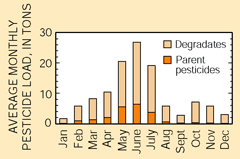 |
| Figure 25. The most frequently used pesticides begin breaking down before being transported from the Study Unit to the Mississippi River. More than 80 percent of the yearly pesticide load in the Iowa River at Wapello is pesticide degradates. Of the yearly load, about 57 percent was transported from the Study Unit during May, June, and July. |
Runoff from rains soon after application washes large quantities of pesticides into streams. Concentrations of pesticides and their degradates were highest in the late spring and early summer when intense rains occurred soon after application (fig. 23). Pesticides and their degradates are transported from the Eastern Iowa Basins in largest quantities during the late spring and early summer. Pesticide degradates make up the largest part of the pesticide load transported to the Mississippi River. Pesticide data from the Iowa River at Wapello, Iowa, illustrate that the monthly degradate load was higher than the loads of the parent compounds throughout the year (fig. 25) but were particularly dominant during the spring and early summer and late fall and winter periods. Typically, the loads for all compounds were largest during the spring and early summer (March through June) when significant runoff events transported pesticide compounds to streams. In the fall and winter months, however, the pesticide degradates accounted for nearly all of the pesticide loads (fig. 25). Parent compounds accounted for only 3 percent (December) to 27 percent (May) of the total pesticide compounds transported from the Iowa River. Much of the water and dissolved pesticide compounds originated from ground-water inflow during the relatively dry late fall and winter months. The presence of relatively high concentrations of alachlor and metolachlor degradates in the fall and winter, several months after pesticide application when parent compounds have all but disappeared, indicates that these compounds are relatively stable.
The gasoline additive MTBE was the most commonly detected volatile organic compound in ground water. Shallow alluvial ground water in urban areas is susceptible to contamination from organic compounds resulting from activities such as transportation, manufacturing, and service industries. Volatile organic compounds (VOCs) were detected in 40 percent of alluvial samples from urban areas and 10 percent of the samples from agricultural areas. Methyl tert-butyl ether was the most frequently detected VOC and was present in 23 percent of samples from urban areas (fig. 26). Although most detected concentrations were low, MTBE concentrations from two urban monitoring wells were at levels of potential concern for human health (USEPA drinking-water advisory of 20 to 40 mg/L). MTBE was commonly found with other gasoline compounds (benzene, ethylbenzene, toluene, and xylene), indicating that contamination likely originated from leaking fuel storage tanks and possibly from surface spills. MTBE was not detected in agricultural areas. Solvents were detected in less than 15 percent of the samples, and other VOCs were detected in less than 10 percent of the samples.
Water from deeper in the alluvial aquifers and in the deeper Silurian-Devonian and Upper Carbonate bedrock aquifers used for rural domestic supply rarely contained detectable concentrations of VOCs, even though gasoline is commonly stored and solvents are at times used in the vicinity of these wells.
Pesticides banned or restricted in the 1970s and 1980s are still present in fish tissue. Although no longer in use, residue from organo-chlorine insecticides (chlordane, DDT, dieldrin, and heptachlor epoxide) is still found in fish-tissue samples collected from eastern Iowa streams (Roberts, 1997) but not at levels of concern for human health. Concentrations were relatively higher in agricultural than urban streams, and fish from the Wapsipinicon River Basin contained lower concentrations of contaminants than fish from the Cedar or Iowa River Basins. Although aldrin, an organochlorine pesticide, has been banned since the 1970s, its degradate, dieldrin, was present in five stream samples during or immediately following spring runoff. Dieldrin was present in tissue samples collected from carp at 15 of 16 sites in eastern Iowa, and concentrations in fish seem to be associated with agricultural settings (Roberts, 1997). Concentrations that peaked in sediment deposited in Coralville Reservoir during the 1993 flood indicate that dieldrin is still transported in rivers during high flow (Kalkhoff and Van Metre, 1997). In contrast to the apparent agricultural source of dieldrin, the occurrence and concentration of PCBs (polychlor-inated biphenyls) in fish tissue indicate an urban source for this contaminant (Roberts, 1997).
Methyl tert-butyl ether (MTBE), a compound added to gasoline to enhance the octane content or to ensure cleaner burning with reduced carbon monoxide emissions, was detected in the alluvial aquifers underlying towns and cities in the Eastern Iowa Basins at a rate similar to the average detection rate in the United States (Squillace and others, 1999). However, detection rates (fig. 26) were not as great as in shallow, vulnerable aquifers in Denver, Colorado (Bruce and McMahon, 1996), and other areas where MTBE has been used extensively to reduce carbon monoxide emissions. MTBE also has been detected in areas where MTBE is used only to enhance the octane content (Zorgorski and others, 1997). Although ethanol is commonly added to gasoline in Iowa, MTBE has also been added to increase the octane level. Legislatively mandated sampling of soil and ground water from leaking underground storage tank (LUST) sites in Iowa verified that MTBE is prevalent in gasoline-contaminated areas (Iowa Department of Natural Resources, 2000b). MTBE was present in ground water at about 59 percent of the 523 LUST sites in 248 Iowa towns and cities. The effects of MTBE on human health are not fully understood, but MTBE has been linked to headaches, nausea, dizziness, and breathing difficulties (Melnick and others, 1997). Experimental studies indicate that MTBE is carcinogenic in rats and mice (Melnick and others, 1997). |
Biological Communities and Stream Habitat
The quality of water entering from runoff and ground water inflow is an important factor that influences the community structure of fish, invertebrates, and algae that live in the rivers and streams of the Eastern Iowa Basins. Stream habitat, the physical conditions in and along streams and rivers, also influences the occurrence and distribution of aquatic organisms. Water-quality degradation and habitat alteration resulting from agricultural and urban activities can adversely affect aquatic communities.
In general, degradation results in the replacement of native species with those that are more tolerant of nutrient and organic enrichment. There also tends to be a reduction in numbers of sensitive species, increases in abundance and dominance of tolerant species, and decreases in the diversity and evenness of biological communities that are typically considered an indicator of environmental stress.
Biological metrics that contain measures of the composition, abundance, function, and tolerance of species to environmental stress are commonly used to evaluate aquatic communities in relation to water quality and habitat conditions.
|
Biological communities (algae, fish, and invertebrates) in streams in the Eastern Iowa Basins generally rank in the middle 50th to highest 25th percentile most tolerant of environmental degradation nationally (fig. 27). Commonly, biological communities in streams change in response to environmental changes (degradation). Degradation can result from a variety of factors that modify habitat or other environmental features such as land use, water chemistry, streamflow, and others. The biological community may change from few individuals of many species to a community of many individuals of a few tolerant species. Algal status focuses on the changes in the percentage of certain algae in response to increasing siltation and seems to correlate relatively well with higher nutrient concentrations in many regions. Invertebrate status is the average of 11 invertebrate (primarily insects, worms, crayfish, and clams) metrics that summarize changes in richness, tolerance, trophic conditions, and dominance associated with water-quality degradation. Fish status is the sum of scores of four fish metrics (percent tolerant, omnivorous, non-native individuals, and percent individuals with external anomalies) that change (increase) in association with water-quality degradation. For all indicators, higher values indicate a more degraded stream site. Community differences occur among streams in the Eastern Iowa Basins, but these differences are small in relation to differences across the Nation. From a national perspective, algal status was moderate to high in all Study Unit streams and rivers and corresponds with high concentrations of dissolved and total nutrients. With one exception (Wapsipinicon River near DeWitt), invertebrate status tended to rank in the middle to lowest 25th percentile, indicating a moderate degree of degradation in relation to the rest of the Nation. Because of nutrient enrichment and subsequent abundance of algae and organic material, an abundant food supply is present to support a diverse invertebrate community. From a local and regional perspective, invertebrate status indicated greater degradation in large rivers than small streams. However, lower status in the Skunk River may be associated more with better habitat at that site than any quantitative differences in water chemistry among other large rivers. Fish communities tended to be ranked highest (most degraded) to moderate when compared nationally. Based on the presence of more species sensitive to environmental stress, the fish population at Wapsipinicon River near DeWitt was minimally affected by environmental degradation in relation to other sites nationally.
|
Fish populations are related to stream size and water-quality conditions. During 1996–98, 67 fish species representing 15 families were collected in six streams and six rivers in the Eastern Iowa Basins (Sullivan, 2000). The species and trophic composition, as well as the abundance and condition of fish communities, varied between the smaller streams and large river sites in the Eastern Iowa Basins. Measures of fish-community status, tolerance, structure, and index of biotic integrity (IBI) indicated that fish communities also differed among land uses and landforms in the basin (fig. 28). Habitat and water-quality data indicate that differences in species composition between rivers and streams are probably due to more than just stream size. Although differences in stream size and associated habitat differences favor the occurrence of different species, relatively higher concentrations of suspended sediment and phosphorus in large rivers may contribute to habitat degradation and eutrophication that may explain the relatively lower IBI scores at large river sites (Sullivan, 2000).
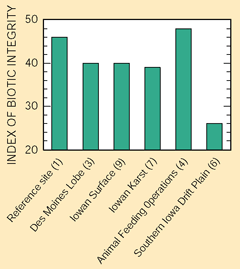 |
| Figure 28. Healthy fish populations were present in one of the least affected (reference) and one of the most affected (animal feeding operations) streams in the study area. Factors other than water quality (stream habitat) also have an important effect on fish populations. (Site number in parentheses; see site map in “Study Unit Design” Section.) |
The two highest IBI-rated river sites were the Wapsipinicon River near DeWitt and the Cedar River at Gilbertville, an integrator site for the upper Cedar River watershed. River sites with the lowest IBI scores include the Skunk River at Augusta and three sites in the Iowa River Basin: Iowa River at Marengo, Old Mans Creek near Iowa City, and the most downstream integrator site (Iowa River at Wapello).
Agriculture and subsequent organic enrichment of the streams have likely reduced habitat, cover, and water-quality requirements for the maintenance of diverse fish populations and communities. However, the small number of fish species in Flood Creek (fig. 27) may be reflective of the karst hydrology in the basin; extended reaches of Flood Creek may be dry during low-flow conditions or periods of drought, limiting fish communities to juvenile fish or those with rapid recolonization rates.
Macroinvertebrate communities in the Eastern Iowa Basins reflect cumulative effects of both land use and downstream succession—the natural sequence of communities from headwater streams to large rivers (Vannote and others, 1980). More than 250 benthic invertebrate taxa were found in collections from submerged woody debris at 12 Basic Fixed Sites (see Glossary). Aquatic insects, including mayflies, net-spinning caddisflies, and midges, accounted for more than one-half of the organisms collected. The abundance of highly tolerant midges (Chironomidae) and worms (Oligochaeta), as well as collector-filterers was higher in large rivers, whereas the abundance of less-tolerant mayflies, stoneflies, and caddisflies (EPT taxa; see Glossary) was relatively larger in small tributary streams (Brigham and Sadorf, 2001). However, most invertebrate taxa in eastern Iowa streams and rivers are considered to be tolerant of nutrient and organic enrichment (Hilsenhoff, 1987). Stream velocity, rates of stream respiration, minimum dissolved oxygen, wooded-riparian zones, and the composition and abundance of periphyton were the primary factors associated with invertebrate community structure (M.A. Harris, U.S. Geological Survey, written commun., 2000).
In general, invertebrate diversity was lower in unshaded streams with silt, sand, or gravel bottoms (for example, Iowa River near Rowan and Old Mans Creek) than in shaded streams with bedrock or large rocks (for example, Flood Creek and Wapsipinicon River near Tripoli). Despite similarities in agricultural land-use intensity in the Midwestern Corn Belt, invertebrate communities reveal substantial differences in the quality of streams and rivers, corresponding to physical (modifications of stream channels and riparian zones) and hydrologic (rainfall-runoff and ground-water relations) differences among basins (M.A. Harris, U.S. Geological Survey, written commun., 2000).
Algal communities are dominated by nutrient- and sediment-tolerant taxa. More than 330 algal species were found in periphyton collections from submerged woody debris. Algal communities were dominated by taxa that are tolerant to nutrients and other agricultural contaminants such as herbicides and sediment.
Relative differences are seen in algal status (an indicator of nutrient and sediment enrichment) and biomass among sites from a regional and local perspective. For example, algal biomass (the amount of attached algae) was relatively higher in Old Mans Creek, Flood Creek, and the Cedar River at Gilbertville than other sites. Within the Eastern Iowa Basins, algal status was relatively better in the Wapsipinicon River near Tripoli (the reference site) and in the Cedar River near Gilbertville and Conesville.
During low-flow conditions in August 1997, shaded streams that drain permeable soils (for example, the upper Cedar and Wapsipinicon River Basins) were dominated by periphyton taxa (diatoms, red algae, and green algae) that are a good food source for invertebrates and fish. In contrast, channelized streams and rivers with poor riparian shading, impermeable soils, and slow velocity were dominated by phytoplankton taxa (notably blue-green algae) that are avoided as food sources and contribute to organic enrichment, higher rates of stream respiration, and lower dissolved oxygen concentrations during the night (Sorenson and others, 1999; Porter, 2000).
Despite similar land use throughout the Corn Belt region of the Midwest, streams flowing through cropland differ considerably in their ecological characteristics, in part because of differences in riparian buffer zones (see text box). This conclusion is based on an investigation of 70 streams and rivers within three NAWQA Study Units in the upper Midwest during August 1997 (fig. 29; Sorenson and others, 1999; Porter and others, 2001). Specifically, increases in tree cover in buffer zones were associated with aquatic biological communities indicative of good stream quality, reduced nuisance algal growths, and maintenance of sufficient dissolved oxygen concentrations to support diverse communities of aquatic organisms. For example, the number of aquatic insects indicative of good stream quality tended to increase with increases in percentage of tree cover, especially in sites where streamflow and dissolved oxygen conditions were favorable. Fish communities, sampled at 24 sites in the UMIS Study Unit, also indicated better overall conditions in streams with wooded riparian zones than those with more open canopy (Stauffer and others, 2000). Streams with less tree cover, and thus less shading, contained relatively large growths of phytoplankton (algae suspended in the water) at levels considered indicative of eutrophication (Porter, 2000). Organic enrichment resulting from excessive algal production in some Midwestern streams may reduce dissolved oxygen concentrations and be detrimental to other requirements of aquatic organisms. Shading from tree cover in riparian buffer zones may influence nutrient concentrations indirectly by reducing the growth of phytoplankton. In streams where phytoplankton were abundant (often where buffer zones were thin or lacking), dissolved nitrate concentrations were significantly lower (fig. 30; Porter, 2000). The lower nutrient concentrations may result from uptake by the abundant phytoplankton. Thus, assessments of eutrophication would benefit from consideration of biological communities and the riparian zone, rather than being based solely on nutrient concentrations in the water.
|
| Table of Contents || Previous Section || Next Section || Glossary U.S. Geological Survey Circular 1210 Suggested citation:
|


